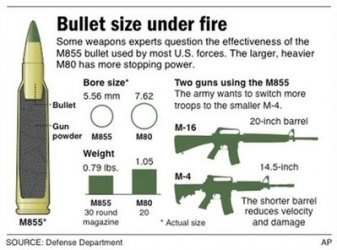I don't know about anyone else but if I'm gonna be in an urban combat situation I want a hard hitting bullet so that when I put it in someone I don't have to worry too much about the guy getting back up and putting one in me.
US uses bullets ill-suited for new ways of war
By RICHARD LARDNER, Associated Press Writer Mon May 26, 8:10 PM ET
http://news.yahoo.com/s/ap/20080527/ap_on_go_ca_st_pe/battling_over_bullets
WASHINGTON - As Sgt. Joe Higgins patrolled the streets of Saba al-Bor, a tough town north of Baghdad, he was armed with bullets that had a lot more firepower than those of his 4th Infantry Division buddies.
As an Army sniper, Higgins was one of the select few toting an M14. The long-barreled rifle, an imposing weapon built for wars long past, spits out bullets larger and more deadly than the rounds that fit into the M4 carbines and M16 rifles that most soldiers carry.
"Having a heavy cartridge in an urban environment like that was definitely a good choice," says Higgins, who did two tours in Iraq and left the service last year. "It just has more stopping power."
Strange as it sounds, nearly seven years into the wars in Afghanistan and Iraq, bullets are a controversial subject for the U.S.
The smaller, steel-penetrating M855 rounds continue to be a weak spot in the American arsenal. They are not lethal enough to bring down an enemy decisively, and that puts troops at risk, according to Associated Press interviews.
Somehow this doesn't make any sense... you can hit a person in the head, even between the eyes or directly in the heart even with a .22 and they could still conceivably survive... at least long enough to do the same to you."If you hit a guy in the right spot, it doesn't matter what you shoot him with," said Maj. Thomas Henthorn, chief of the small arms division at Fort Benning, Ga., home to the Army's infantry school.
Read this sentence carefully will ya?
Is it me or is there something wrong with a bullet that doesn't do well at close range against someone wearing, say, a plain white cotton t-shirt?"The bullet does exactly what it was designed to do. It just doesn't do very well at close ranges against smaller-stature people that are lightly equipped and clothed," says Alexander, who spent most of his 26-year military career with the 5th Special Forces Group.
If we're going to keep our troops there in Iraq, fighting in probably one of the worse conditions that ANY combat soldier has to fight in (close-quarter urban combat or street to street fighting... in the enemy's hometown!!)... then at least give them the advantage of having superior firepower/ammunition no-matter what kind of gun they put in their hands.
And this I agree with.
Shooting as few rounds as possible helps cut down on shooting possible friendlies... and children.With the M855, troops have to hit their targets with more rounds, said Howe, who owns a combat shooting school in Texas. That can be tough to do under high-stress conditions when one shot is all a soldier might get.
"The bullet is just not big enough," he says. "If I'm going into a room against somebody that's determined to kill me, I want to put him down as fast as possible."
Anyone else get this? I get the feeling that I might be missing something here.

